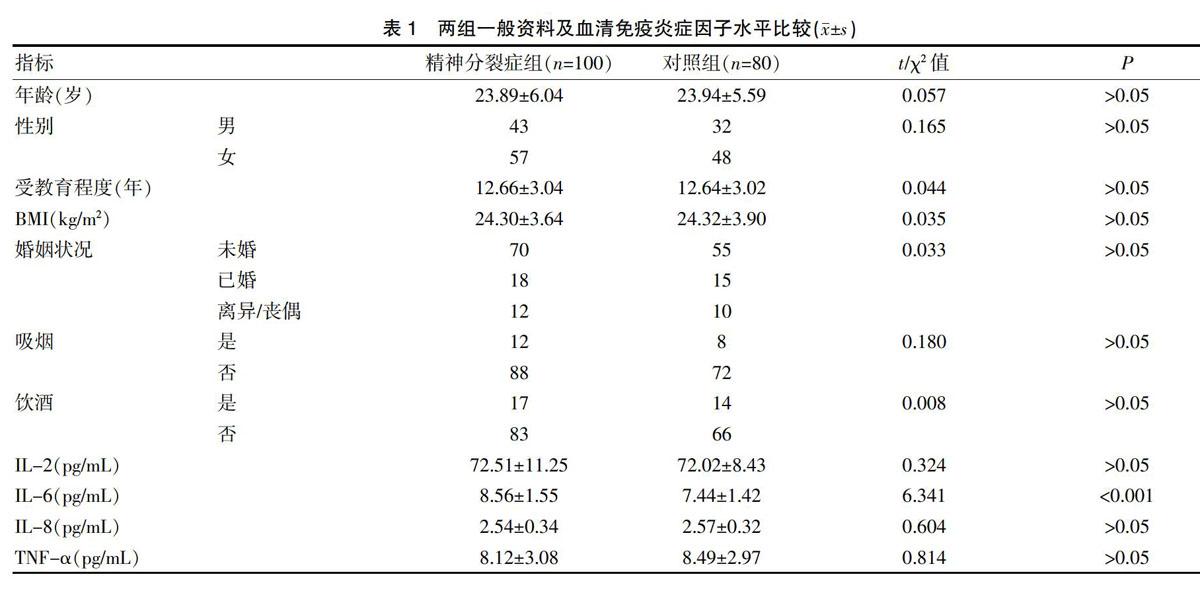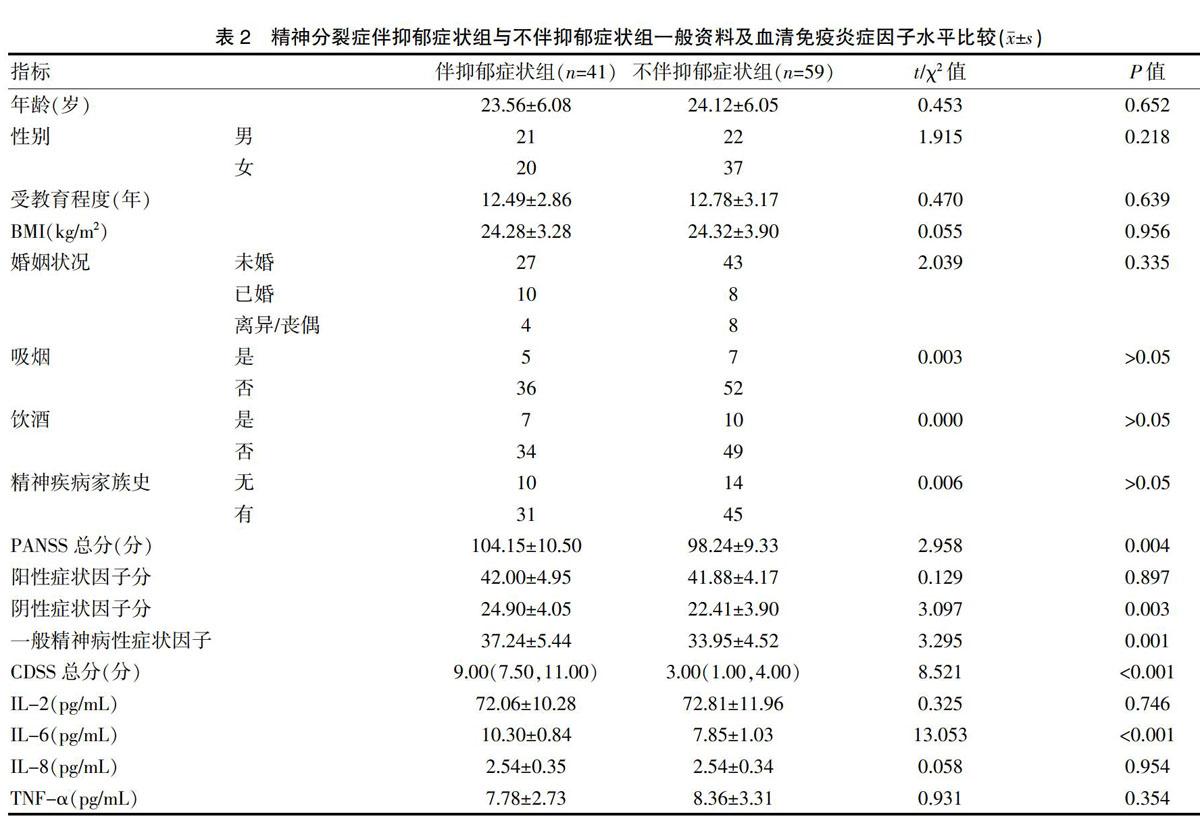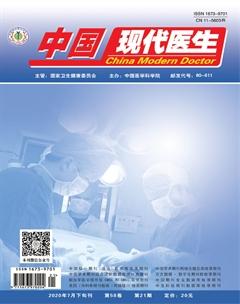首发未服药精神分裂症患者血浆IL-6水平与抑郁症状的相关性
杨金玲 林霜 曹阳 李亚平 刘兰英



[摘要] 目的 探讨首发未服药精神分裂症患者血浆促炎细胞因子IL-2、IL-6、IL-8、TNF-α与抑郁症状的关系。方法 选择浙江省立同德医院(浙江省精神卫生中心)2017年10月~2018年12月诊治的首发未服药精神分裂症患者100例为精神分裂症组;选择同期该地区社会招募的健康人群80例为对照组。采用阳性和阴性症状量表(Positive and negative syndrome scale,PANSS)评估患者的精神症状,采用卡尔加里精神分裂症抑郁量表(Calgary depression scale for schizophrenia,CDSS)评估患者抑郁症状的严重程度。采用雙抗体夹心ABC-ELISA法检测所有受试者血浆IL-2、IL-6、IL-8、TNF-α浓度。根据CDSS评分将精神分裂症患者分为伴抑郁症状组(CDSS≥7分)和不伴抑郁症状组(CDSS<7分)。分析促炎细胞因子水平与精神分裂症抑郁症状的相关性。 结果 精神分裂症患者血浆IL-6水平显著高于健康对照组(t=6.341,P<0.001);精神分裂症伴抑郁症状组PANSS总分、阴性症状因子分和一般精神病性症状因子分均高于不伴抑郁症状组(P<0.05)。伴抑郁症状组血浆IL-6水平明显高于不伴抑郁症状组或健康对照组(Bonferroni校正后P<0.001);而不伴随抑郁症状组与对照组IL-6水平无显著差异(Bonferroni校正后P>0.05)。相关性分析显示,精神分裂症患者血浆IL-6水平与抑郁症状呈明显正相关(r=0.294,P<0.001)。结论 首发未服药精神分裂症患者外周高水平的IL-6与抑郁症状的发生有关。
[关键词] 精神分裂症;抑郁症状;细胞因子;白介素6
[中图分类号] R749.3 [文献标识码] A [文章编号] 1673-9701(2020)21-0006-05
Correlation between plasma IL-6 levels and depressive symptoms in unmedicated patients with first-episode schizophrenia
YANG Jinling1 LIN Shuang1 CAO Yang2 LI Yaping3 LIU Lanying2
1.Department of General Internal Medicine, Zhejiang Provincial Tongde Hospital Affiliated to Zhejiang University of Traditional Chinese Medicine, Zhejiang Institute of Traditional Chinese Medicine, Zhejiang Mental Health Center, Hangzhou 311100, China; 2.Department of Psychiatry, Zhejiang Provincial Tongde Hospital Affiliated to Zhejiang University of Traditional Chinese Medicine, Zhejiang Institute of Traditional Chinese Medicine, Zhejiang Mental Health Center, Hangzhou 311100, China; 3.Department of Science and Education, Zhejiang Provincial Tongde Hospital Affiliated to Zhejiang University of Traditional Chinese Medicine, Zhejiang Institute of Traditional Chinese Medicine, Hangzhou 311103, China
[Abstract] Objective To investigate the relationship between the plasma proinflammatory cytokines interleukin-2(IL-2), IL-6, IL-8 and TNF-α and the depressive symptoms in unmedicated patients with first-episode schizophrenia. Methods A total of 100 unmedicated patients with first-episode schizophrenia(Schizophrenia group) and 80 healthy controls(control group) were selected from Zhejiang Provincial Tongde Hospital from October 2017 to December 2018. The patient's psychiatric symptoms were assessed using the Positive and Negative Syndrome Scale(PANSS), and the severity of depressive symptoms was assessed using the Calgary Depression Scale for Schizophrenia(CDSS). The plasma IL-2, IL-6, IL-8, and TNF-α concentrations were measured in all subjects by double antibody sandwich ABC-ELISA. The patients with schizophrenia were divided into a group with depressive symptoms(CDSS≥7 points) and a group without depression(CDSS<7 points) according to the CDSS score. The correlation between the pro-inflammatory cytokine levels and the depressive symptoms of schizophrenia was analyzed. Results It was found that the plasma IL-6 levels in patients with schizophrenia were significantly higher than those in healthy controls(t=6.341, P<0.001). The total score of PANSS, negative symptom factor score and general psychotic symptom factor score in the group with depressive symptoms were higher than those in the group without depressive symptoms(P<0.05). It was further discovered that the plasma IL-6 level in the group with depressive symptoms was significantly higher than that in the group without depressive symptoms and the healthy controls(P<0.001 after Bonferroni correction), and there was no significant difference in the IL-6 level between the two groups(P>0.05 after Ponferroni correction). It was found by correlation analysis that the plasma IL-6 levels were significantly and positively correlated with the depressive symptoms in patients with schizophrenia(r=0.294, P<0.001). Conclusion High peripheral levels of IL-6 in unmedicated patients first- episode schizophrenia are associated with the occurrence of depressive symptoms.
[Key words] Schizophrenia; Depressive symptoms; Cytokines; Interleukin-6
抑郁症状是精神分裂的常见症状之一,可出现在精神分裂症病程中的任何时期,尤其是急性期,其发生率高达25%~81%[1]。抑郁症状的出现可导致患者预后不良和社会功能受损加重[2],严重时可增加患者的自杀风险[3-4]。因此及早识别精神分裂症患者的抑郁症状,探讨抑郁症状发生的生物学机制,对促进患者预后、降低自杀行为的发生具有重要意义。近年来,精神分裂症的神经免疫机制受到极大关注。神经发育假说认为,母亲免疫感染可增加子代罹患精神分裂症的风险[5]。然而由于精神分裂症存在多维度临床症状(阳性症状、阴性症状、认知障碍、情感症状等),有学者认为精神分裂症免疫炎症可能与特定的临床症状维度相关[6]。白细胞介素2(Interleukin-2,IL-2)、IL-6、IL-8、肿瘤坏死因子α(Tumor necrosis factor-α,TNF-α)作为重要的促炎细胞因子,其异常水平在既往精神分裂症和抑郁症患者中均有报道[7]。本研究旨在探讨首发未服药精神分裂症患者的抑郁症状与血浆促炎细胞因子IL-2、IL-6、IL-8、TNF-α的关系,现报道如下。
1 资料与方法
1.1 一般资料
选择浙江省立同德医院(浙江省精神卫生中心)2017年10月~2018年12月诊治的首发未服药精神分裂症患者100例为精神分裂症组。纳入标准:患者由两名精神科医师分别进行独立诊断,均符合DSM-IV精神分裂症诊断标准[8];年龄18~40岁;汉族;首次表现出精神病性症状且总病程≤1年;发病以来未使用抗精神病药物或用抗精神病药物治疗时长≤2周;阳性和阴性症状量表(Positive and negative syndrome scale,PANSS)总分≥60分;自愿参与此项研究并签署知情同意书。排除标准:符合精神分裂症以外的其他DSM-IV轴I精神障碍的诊断;属于躯体疾病、脑器质性疾病所致精神障碍者;近1个月内服用免疫炎症药物(如治疗自身免疫性疾病、感染或其他炎症疾病的药物)的患者;孕妇或哺乳期妇女;酒依赖或精神活性物质使用者。
选择同期该地区社会招募的健康人群80例为对照组。纳入标准:年龄18~40岁;汉族;自愿参加本项研究并签署知情同意书。排除标准:根据DSM-Ⅳ标准,既往或目前被诊断为具有精神障碍者;精神疾病患者近亲属;酒依赖或精神活性物质使用者;严重躯体疾病患者;近1个月内服用免疫炎症药物(如治疗自身免疫性疾病、感染或其他炎症疾病的药物)的患者;孕妇或哺乳期妇女;酒依赖或精神活性物质使用者。
1.2 方法
(1)一般资料及临床信息收集:收集所有受试者的一般资料,包括年龄、性别、受教育年限、体重指数(Body mass idex,BMI)、婚姻状况、吸烟和饮酒情况等;收集精神分裂症患者的发病年龄、精神疾病家族史等。(2)精神癥状评估:采用阳性和阴性症状量表(Positive and negative syndrome scale,PANSS)[9]评估患者的精神症状,该量表包括阳性症状分、阴性症状分、一般精神病理症状分、量表总分为评估指标,总分为30~210分。(3)抑郁症状评估:采用卡尔加里精神分裂症抑郁量表(Calgary depression scale for schizophrenia,CDSS)评估精神分裂症患者抑郁症状的严重程度,该量表由加拿大卡尔加里大学的D.Addington和J.Addington教授等[10]编制而成,中文版由北京大学精神卫生研究所张鸿燕教授等翻译,总分0~27分,在中国人群中具有良好的信效度。参照既往文献[11],本研究以CDSS-C总分≥7分作为有抑郁症状的判断标准,据此将100例患者分为伴抑郁症状组41例(≥7分)和不伴抑郁症状组59例(<7分)。以上量表在患者入组当天由2名经过一致性培训的精神病学专科医生独立评估,2名评估员组内相关系数(The interclass correlation coefficient,ICC)>0.80。(4)血浆IL-2、IL-6、IL-8、TNF-α水平检测:所有研究对象于早晨抽取空腹静脉血5 mL,置于10%EDTA采血管中,轻摇混匀防止血液凝固,然后将血样转移至含抑蛋白酶肽的离心管中,轻摇混匀,4℃ 1600 r/min离心15 min,分离血浆于-80℃冰箱中保存备用。采用双抗体夹心ABC-ELISA法检测血浆IL-2、IL-6、IL-8、TNF-α浓度,试剂准备和检测程序严格遵守相应试剂盒(上海派成绕生物科技有限公司)说明书,使用Muhiskan MK3酶标仪(Thermo Electro Corportation,美国)完成实验操作。
1.3 统计学方法
采用Epidata3.1进行数据双录入,使用SPSS 23.0进行统计学分析。计量资料以(x±s)或中位数(四分位数间距)表示。组间分类资料采用χ2检验;计量资料比较采用两独立样本t检验(正态)、非参数检验采用曼-惠特尼U测试(非正态)、协方差分析控制潜在混杂因素以比较各组之间IL-2、IL-6、IL-8、TNF-α水平的差异,并采用Bonferroni进行多重校正。血清免疫炎症因子水平与临床症状的相关性采用Pearson相关性分析。所有统计检验均为双侧检验,P<0.05表示差异有统计学意义。
2 结果
2.1 两组一般资料及血清免疫炎症因子水平比较
精神分裂症组:男43例、女57例;年龄(23.89±6.04)岁;受教育年限(12.66±3.04)年;BMI(24.30±3.64)kg/m2;婚姻状况(未婚70例、已婚18例、离婚12例);吸烟状况(吸烟12例、从不吸烟88例);饮酒习惯(饮酒17例、从不饮酒83例);血浆IL-2、IL-6、IL-8、TNF-α水平分别为(72.51±11.25)pg/mL、(8.56±1.55)pg/mL、(2.54±0.34)pg/mL、(8.12±3.08)pg/mL。对照组:男32例、女48例;年龄(23.94±5.59)岁;受教育年限(12.64±3.02)年;BMI(24.32±3.90)kg/m2;婚姻状况(未婚55例、已婚15例、离婚10例);吸烟状况(吸烟8例、从不吸烟72例);饮酒习惯(饮酒14例、从不饮酒66例);血浆IL-2、IL-6、IL-8、TNF-α水平分别为(72.02±8.43)pg/mL、(7.44±1.42)pg/mL、(2.57±0.32)pg/mL、(8.49±2.97)pg/mL。两组的年龄、性别、受教育程度、BMI、婚姻状况、吸烟、饮酒习惯比较,差异均无统计学意义(P>0.05)。精神分裂症组血浆IL-6水平显著高于对照组(t=6.341,P<0.001),控制年龄、性别及BMI因素后,两组之间的差异仍有统计学意义(P<0.001)。见表1。
[19] Frydecka D,Krzystek-Korpacka M,Lubeiro A,et al.Profiling inflammatory signatures of schizophrenia:A cross-sectional and meta-analysis study[J].Brain Behav Immun,2018,71:28-36.
[20] Anderson G,Maes M,Berk M.Schizophrenia is primed for an increased expression of depression through activation of immuno-inflammatory,oxidative and nitrosative stress,and tryptophan catabolite pathways[J].Prog Neuropsychopharmacol Biol Psychiatry,2013,42:101-114.
[21] Kwiatkowska B,Klak A,Maslinska M,et al.Factors of depression among patients with rheumatoid arthritis[J].Reumatologia,2018,56(4):219-227.
[22] Petrikis P,Voulgari PV,Tzallas AT,et al.Cytokine profile in drug-naive,first episode patients with psychosis[J].J Psychosom Res,2015,79(4):324-327.
[23] 張载福,杨帆,王卫平,等.血清白介素6水平与抑郁发作的关系[J].临床精神医学杂志,2017,5:340-342.
[24] Kakeda S,Watanabe K,Katsuki A,et al.Relationship between interleukin(IL)-6 and brain morphology in drug-naive,first-episode major depressive disorder using surface-based morphometry[J].Sci Rep,2018,8(1):10054.
[25] Wysokinski A.Serum levels of brain-derived neurotrophic factor(BDNF)and neurotrophin-3(NT-3)in depressed patients with schizophrenia[J].Nord J Psychiatry,2016,70(4):267-271.
(收稿日期:2019-08-05)

